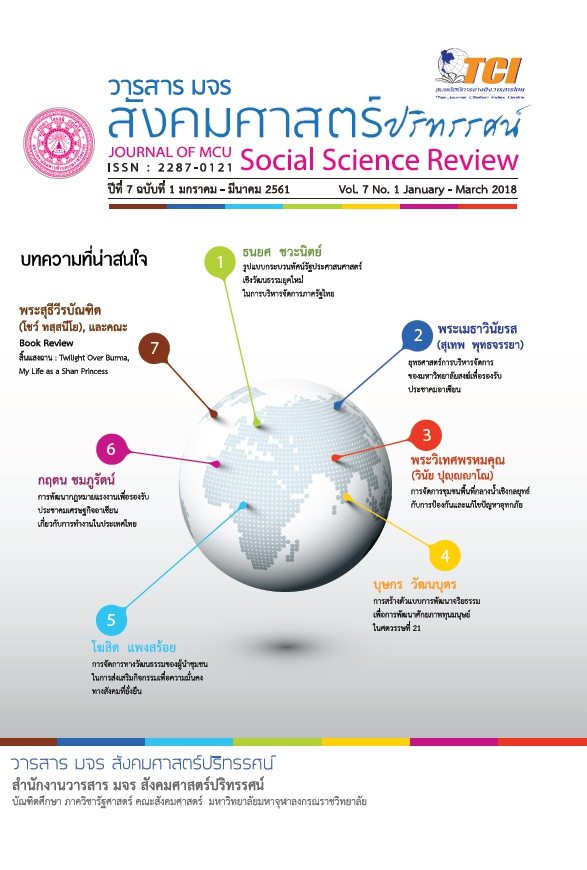INTEGRATION OF BUDDHADHAMMA IN INFORMATION COMMUNICATION AND TECHNOLOGY UTILIZATION
Abstract
The objectives of the research entitled integration of Buddhadhamma in information communication and technology utilization were; 1) to study the theories on using information communication and technology, 2) to study the principles of Buddhadhamma, 3) to integrate the principles of buddhadhamma with information communication and technology, and 4) to propose guidelines in building new knowledge. The study employed documentary qualitative method conducting an in-depth interview and focus group dicussion.
The results were indicated that information communication and technology helps to obtain accurate information in no time which is beneficial for business and the quality of life. As for technology related crimes can be effectively handled by law enforcement organization using security system as well as ethical laws but solving the symptoms not the root cause. so the principles of Buddhadhamma have been applied to ict, these are hiri and ottappa, the five precepts and Dhamma, yonisomanasikara and kalamasutta kangkhaniyathana.
The integration of Buddhaddhamma principles to solve criminal problems is essential to indoctrinate social responsibility since childhood. Do utilize it and do not violate the social regulation. To prevent violation of intellectual property with Buddhadhamma must be resolved by raising awareness of consequences of sinful conducts as well as having respect for others’ innovation. In order to resolve the problem of wrong ict’s using, it can begin from investigate the message, the sender and the receiver based on one’s consciousness so that guidelines can be determined with virtue and usefulness based on the new body of knowledge named gris model.
References
His Holiness Nanasangvara, Supreme Patriarch (Charoen Suvaddhana Mahathera). (2006). Buddhist Principle. Bangkok: Mahamakut Buddhist University Press.
Kenneth C. Laudon and Jane P. Laudon. (2007). Management Information System (Managing The Digital Firm). Tenth Edition.
Mahachulalongkornrajavidyalaya University. (1996). The Tipitaka in Thai Version belonging to Mahachulalongkornrajavidyalaya University. Bangkok: Mahachulalongkornraja-vidyalaya University.
Michael E. Whitman and Herbert J. Mattord. (2005) “Principles of Information Security”. Second Edition. Thomson Course Technology.
Panida Panichkul. (2013). Information Security and Management. Bangkok: KTP Com and Consult, Ltd. Press.
Phra Bhramagunabhorn (P.A.Payutto). (2013). Thinking Method in Buddhadhamma. Reprinted No.24 by Chapter Division. Bangkok: Plidhamma in Petandhome Co.Ltd.
Phra Mahabodhivongsacarya (Thongdi). (2015). 5 Precepts Protect the World. Bangkok: Banluedhamma Institute.
Phrasuthirattanabundit (Suthita Aphakaro) Dr. (2016). List Model for Research and Social Development. Advance Research Methodology in Social Sciences Development. Social Development Department. Social Sciences. Mahachulalongkornrajavidyalaya University. (Photocopy)
Robert N. Barger. (2008). “Computer Ethics a Case-Based Approach”. Cambridge University Press. United Kingdom.
Downloads
Published
How to Cite
Issue
Section
License
Copyright (c) 2019 Journal of MCU Social Science Review

This work is licensed under a Creative Commons Attribution-NonCommercial-NoDerivatives 4.0 International License.
In order to conform the copyright law, all article authors must sign the consignment agreement to transfer the copyright to the Journal including the finally revised original articles. Besides, the article authors must declare that the articles will be printed in only the Journal of MCU Journal of Social Sciences. If there are pictures, tables or contents that were printed before, the article authors must receive permission from the authors in writing and show the evidence to the editor before the article is printed. If it does not conform to the set criteria, the editor will remove the article from the Journal without any exceptions.





